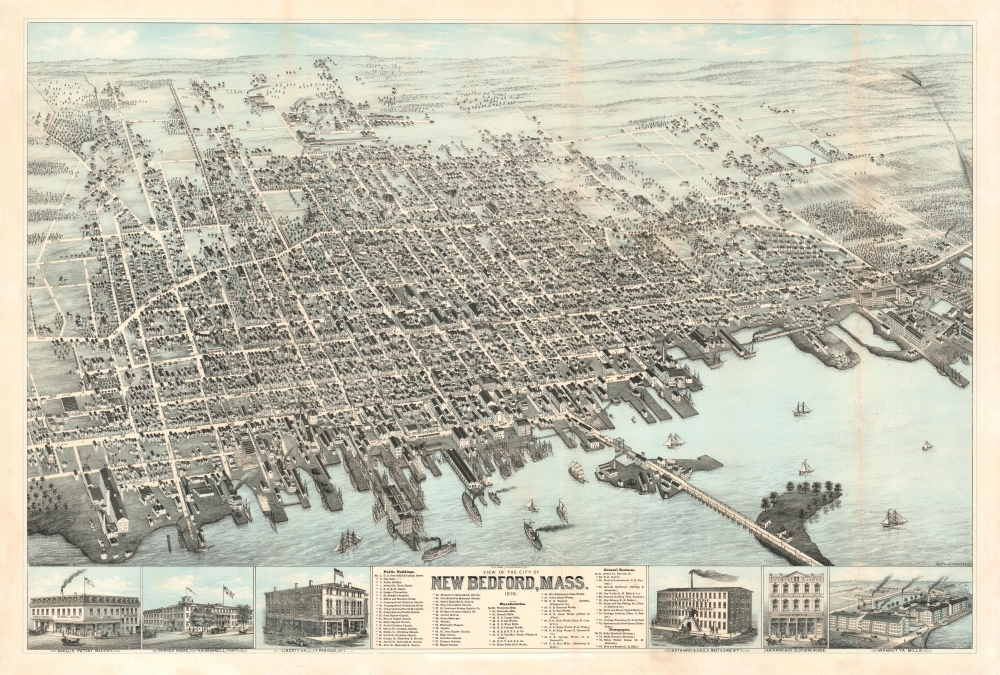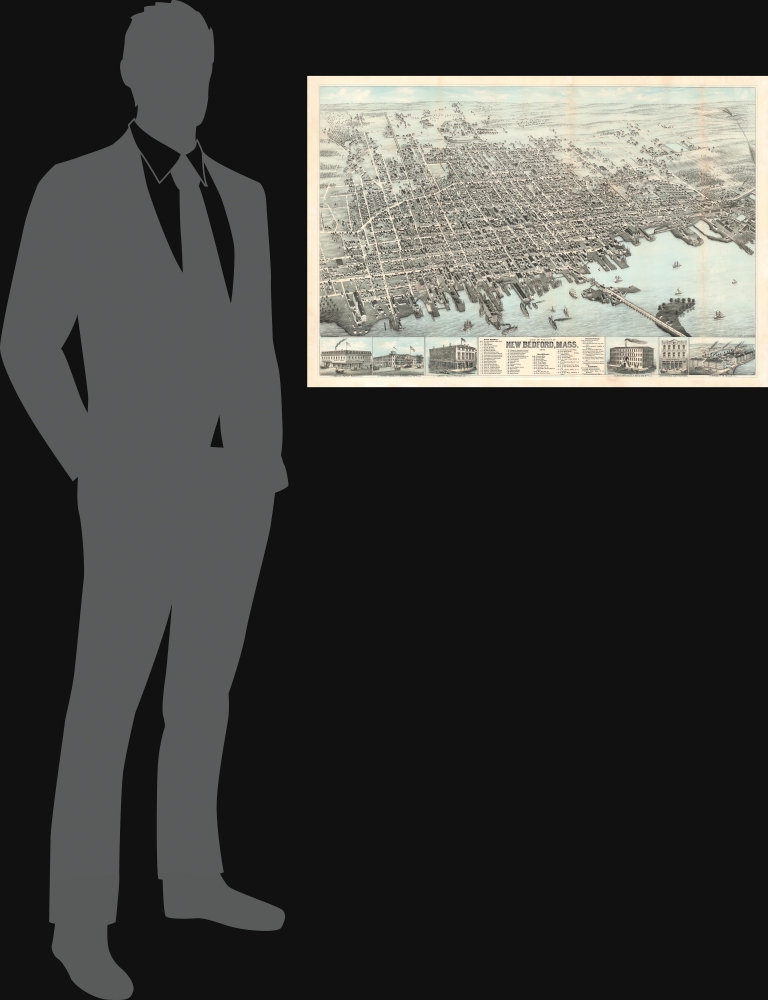1876 Bailey Bird's Eye View of New Bedford, Massachusetts
NewBedford-bailey-1876
Title
1876 (dated) 18.9 x 33.1 in (48.006 x 84.074 cm)
Description
Historical Context
When New Bedford officially became a city in 1847, it was one of New England's most productive whaling cities, challenging Nantucket and Providence. Whaling dominated the city's economy for most of the century, and that trade fueled the city's initial population boom until around 1860. In 1857, New Bedford was the richest city per capita in the world - but the discovery of petroleum in Pennsylvania led to an inexorable decline in the market for whale oil, and the predations of secessionist commerce raiders during the American Civil War (1861 - 1865) accelerated the decline of an already-fading industry. By the time this view was produced, in 1876, New Bedford was not so much a whaling town as it was a mill town: the textile industry had taken over. In 1875, the Wamsutta Mills on their own processed enough cotton to make more money than that year's entire whaling catch. The textile mills fueled even greater prosperity than whaling, spurring the development of industries to serve the city's rich.A Closer Look
The view identifies 76 public buildings, manufactories, general businesses, and newspapers. Amongst its public buildings are twenty six churches, indicative of prosperity. Among the city's 'Manufactories' are the mammoth Wamsutta, Potomska, and Gosnold Textile Mills, dominating the waterfront. Gas works, copper mills, and cordage works can be seen, but many of the factories are tool and machine works, necessary support for the mills. Soap, spice, shoe, and carriage works figure prominently, serving the needs of the mill owners and others. Six vignettes under the view include a patent bakery, a soap manufactory, a shipping agent, a boot and shoe company, the J and W.R. Wing and Co. clothing house, and Wamsutta.Bailey's New England Phase
By the time this view was drawn, Bailey had resettled from Ohio to Cambridge, Massachusetts, and so this piece is among his later work that focused on towns near his new home. The lithograph was nevertheless executed by the firm of C. H. Vogt in Milwaukee, with whom Bailey had a relationship, and with whom he would continue to work until 1878. Concurrently, Bailey also had his view printed by the Milwaukee firm of Jacob Knauber, a relationship which ended in 1878 or 79. After that point, Bailey's work was either printed in-house, or by the Boston firm of J. C. Hazen.American Bird's-Eye City Views
The tradition of the bird's-eye city view emerged in the United States in the middle part of the 19th century and coincided with the commercial development of lithographic printing. Before the rise of lithography, the ability to own and display artwork in the home was largely limited to the extremely wealthy, the advent of lithographic printing made it possible for everyone to own visually striking artwork. A robust trade developed in portraits of political leaders, allegorical and religious images, and city views.City views were being produced in the United States as early as the 1830s, but the genre exploded after the American Civil War (1861 - 1865). Bridging the gap between maps and pictures, most 19th century American bird's-eye views presented cities to the public from high vantage points. Some were imagined, but others were drawn from hot-air balloons or nearby hills. The presentation, combining high elevation, commercial interest, and new printing technology, created a uniquely American art form, as described by historian Donald Karshan,
Some print connoisseurs believe that it was only with the advent of the full-blown city-view lithograph that American printmaking reached its first plateau of originality, making a historical contribution to the graphic arts. They cite the differences between the European city-view prints and the expansive American version that reflects a new land and a new attitude toward the land.The vogue for bird's-eye city views lasted from about 1845 to 1920, during which period some 2,400 cities were thus portrayed, some multiple times. Although views were produced in many urban centers, the nexus of view production in the United States was Milwaukee, Wisconsin. The major American viewmakers were Stoner, Wellge, Bailey, Fowler, Hill, Ruger, Koch, Burleigh, Norris, and Morse, among others.
Chromolithography
Chromolithography, sometimes called oleography, is a color lithographic technique developed in the mid-19th century. The process involved using multiple lithographic stones, one for each color, to yield a rich composite effect. Oftentimes, the process would start with a black basecoat upon which subsequent colors were layered. Some chromolithographs used 30 or more separate lithographic stones to achieve the desired product. Chromolithograph color could also be effectively blended for even more dramatic results. The process became extremely popular in the late 19th and early 20th centuries when it emerged as the dominant method of color printing. The vivid color chromolithography produced made it exceptionally effective for advertising and propaganda imagery.Publication History and Census
This view is rare, with only five examples cataloged in OCLC. This first state appears in the collections of the American Antiquarian Society Library, Boston Public Library, Harvard University, and the State University of Massachusetts. A second state, with the additional text 'Presented by J. and W. R. Wing and Co., 111 Union Street,' is in the Library of Congress.CartographerS
Oakley Hoopes Bailey (June 14, 1843 - August 13, 1947) was a prolific American viewmaker, artist, and lithographer active in late 19th and early 20th century. Bailey was born in Beloit, Mahoning County, Ohio. He matriculated in 1861 at Mount Union College in Alliance, Ohio, where he studied architecture. At the outbreak of the American Civil War (1861 - 1865) he briefly abandoned his studies for 2 years, wherein he saw combat as a Union solider. After the war, in 1866, he returned to Mount Union to complete his degree. Bailey was the younger brother of another view artist, Howard Heston Bailey (1836 - 1878) and followed his brother into the print business, producing his first city views, of Milwaukee, Wisconsin, in 1871. Active from 1871 to 1926, Bailey is known for more than 375 recorded city views, covering more than 13 states 2 Canadian provinces, making him one of the most active viewmakers in American history. In 1875, he settled in Cambridge, Massachusetts and most of his subsequent work focused on Massachusetts and Connecticut. Bailey worked with many other American viewmakers of the period, including his brother, Howard Heston Bailey, Thaddeus M. Flower, and J. C. Hazen, among others. Even his wife, Sarah F. Bailey (1846 - 19??) got into the business, drawing at least one view, of Watkins Glen, New York. Around 1904, by this time in his 60s, Bailey entered into a publishing partnership with Thomas S. Hughes, publishing their 'aero-views' as 'Hughes and Bailey'. Together, Hughes and Bailey revisited the sites of many of Bailey's early views, remaking them sometimes 20 - 40 years later, the idea being to set them beside the earlier views to show how much the respective towns had changed. The partnership lasted until about 1926. Bailey died in his hometown of Alliance at the ripe old age of 103. More by this mapmaker...
Charles H. Vogt (1823 - 1895) was a Prussian-American lithographer active in Cleveland, Ohio from about 1870 to 1889. Vogt was born Prussia and immigrated to the United States in c. 1860, settling in Iowa. He was established as a lithographer of American city views Davenport, Iowa during the 1860s, then in Milwaukee from 1870 to 1879, then in Cleveland, Ohio, from 1879 to 1889. Vogt worked with his son, Gustav. H. Vogt (c. 1858 - July 12, 1936). Learn More...
Jacob Knauber (1846 – 1905) was a German-American lithographer based in Milwaukee, Wisconsin. Knauber was born in Heidelberg, Germany and emigrated to America as a young man. He apprenticed as a lithographer in St. Louis from 1861. In 1867 he foundered J. Knauber Lithographing Company, which he would eventually run with his three sons, Arthur, Walter, and Richard. The firm specialized in American city views, billheads, letterheads, receipts, and checks. Knauber managed the firm it until his death in 1905. Afterwards it was run by his children until 1946 when it was acquired by Columbia Art Works. Learn More...




